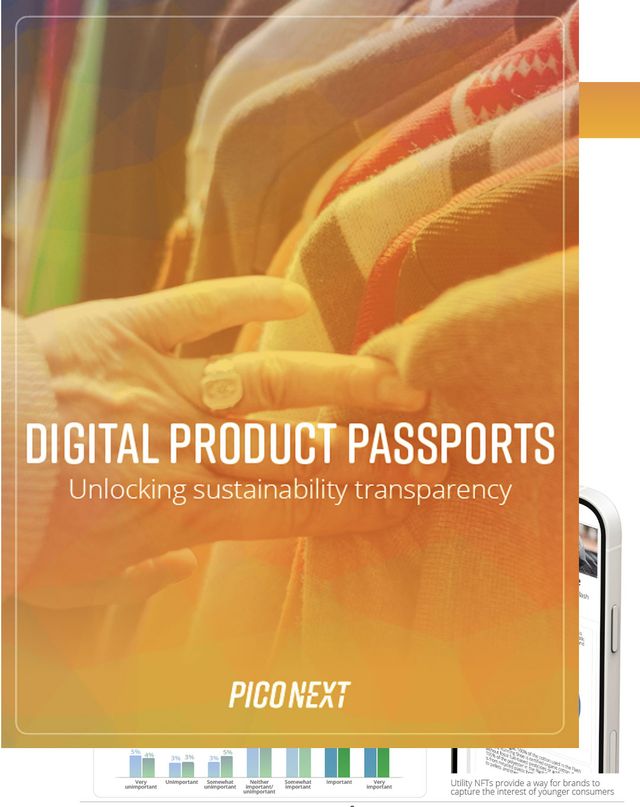In recent years, fast fashion has been popular as a way to engage young, trend-conscious customers with the latest styles. Through frequent launches of new clothing lines; the development of micro-collections; and the use of low-cost, integrated supply chains, fashion brands have attempted to keep pace with ever-changing customer preferences — especially Millennial and Generation Z customers.
And the appetite for fashion doesn’t appear to be slowing. In fact, consumption of textiles is rapidly increasing — by 2030 consumers will buy 102 million tonnes of clothing, a 64 per cent increase from 2022 levels.1
Sustainability concerns for fashion and textiles
As fashion brands and textile producers work to meet the consumer demand for clothing and footwear, they face challenges in creating sustainable clothing. Where fast fashion prioritises quick-turn, inexpensive clothing styles to satisfy the latest trends, sustainable fashion prioritises environmentally responsible production, reuse, and recycling.
In this light, the textile and fashion industries form part of a “key product value chain with an urgent need and a strong potential for the transition to sustainable and circular production, consumption and business models”. 2
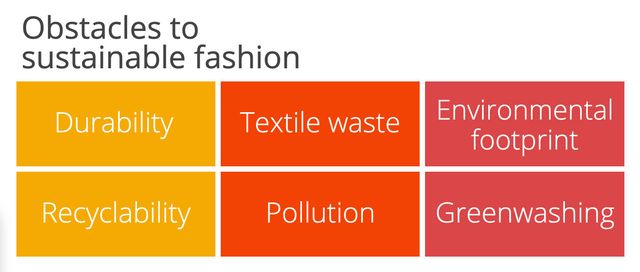
Several key challenges underscore the necessity for the transition to sustainable fashion, including:
Durability. Because style trends are ephemeral in the fast-fashion paradigm, clothing durability is of lower importance. The result is a decrease in the longevity of clothing and footwear pieces, and minimal reuse. Incorporating sustainable design principles at the outset of clothing manufacturing — especially in the areas of zip quality, seam quality, tear strength, and colourfastness — can increase the durability of clothing and its subsequent reuse. 3
Recycling. Constraints in technology impede the efficient recycling of clothing — especially when dealing with blended materials. Separating these blended fibres (like cotton-polyester, or elastane blends) can be technically difficult because of the difficulty in identifying and separating the materials. The result is increased cost, or worse yet, the abandonment of recycling efforts.
Textile waste. In the process of producing and distributing clothing, many textiles are simply discarded. During the manufacturing process, up to 40 per cent of the fabric is either unused or wasted. 4 As mentioned earlier, the composition of fibres used in garments can affect recycling and subsequent waste streams by complicating the sorting process. Unsold products are often destroyed by manufacturers, resulting in additional wasted materials, energy, and labour — not to mention the missed opportunity for reuse. In fact, every second, the equivalent of a truckload of clothing is sent to the landfill or incinerated somewhere in the world. 5
Pollution. Synthetic fibres shed microplastics into the environment, polluting waterways and endangering marine life. Researchers estimate that up to 40,000 tonnes of microplastics are released into water every year when clothing is laundered in washing machines. 6 Reducing this pollution facilitates healthy marine ecosystems and vibrant, clean waterways.
Environmental footprint. The production of synthetic fibres (for example, polyester) is rooted in fossil fuel production. Correspondingly, clothing that uses these synthetic fibres have a substantial carbon emissions footprint, which in turn affects unsustainable climate trajectories. In this regard, the impact that the fashion industry has on the environment can be significant, because analysts estimate that approximately 60 per cent of fibres used in clothing are synthetic. 7 In response, researchers are looking at new types of organic fibres that are not reliant on oil and other fossil fuels in their production.
Greenwashing. Unsubstantiated or misleading environmental claims paint a false picture of some brands’ sustainability efforts. This “greenwashing” tarnishes the efforts of the entire industry to transition to eco-conscious textiles. Greenwashing infractions can result from negligence, sloppy record keeping, complex supply chains, or willful dishonesty. In fact, the enforcement arm of the European Union estimates that approximately 39 per cent of environmental claims in the fashion and textile industry are false. 8
Digital Product Passport for fashion
Initiatives to increase fashion sustainability
To help mitigate these sustainability challenges, the European Union is implementing several textile-related environmental initiatives, including strengthening sustainable product design requirements, promoting research into natural textile fibres, and funding research into areas that support circular economies. One of the main initiatives the trade bloc is launching is a Digital Product Passport for fashion and textiles. This Digital Product Passport is a manifest of sustainability data that travels along with a product, accessed by end-consumers through a data carrier like a QR code.
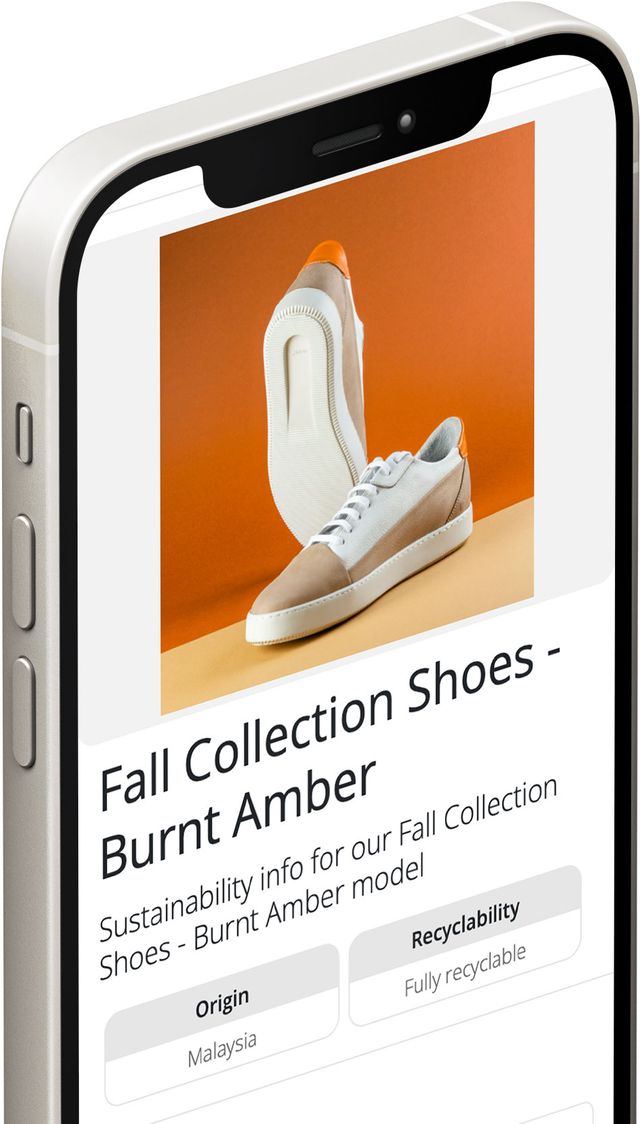
Elevating visibility of fashion sustainability information
Consumers and other stakeholders can view data related to the product prior to purchase that helps inform them about the textile sustainability and environmental footprint of the garment. In addition, consumers can gain information on post-purchase activities that promote reuse, repair, or recycling. Because a Digital Product Passport for fashion helps trace key attributes about the product — including which types of fibres are used to produce the clothing, the conditions under which it was produced, its durability, and any hazardous materials used in composition — consumers will be better able to evaluate the sustainability claims and avoid doing business with companies that greenwash.
Digital Product Passport for fashion requirements
The E.U. has identified fashion and textiles as a priority industry for the Digital Product Passport, along with related product categories including carpets and mattresses. The E.U.’s Ecodesign for Sustainable Products Regulation (ESPR), launched in March 2022, indicates several overarching requirements for these passports. It also anticipates industry-specific regulations to come later, such as which specific product attributes should be included in a Digital Product Passport for fashion.
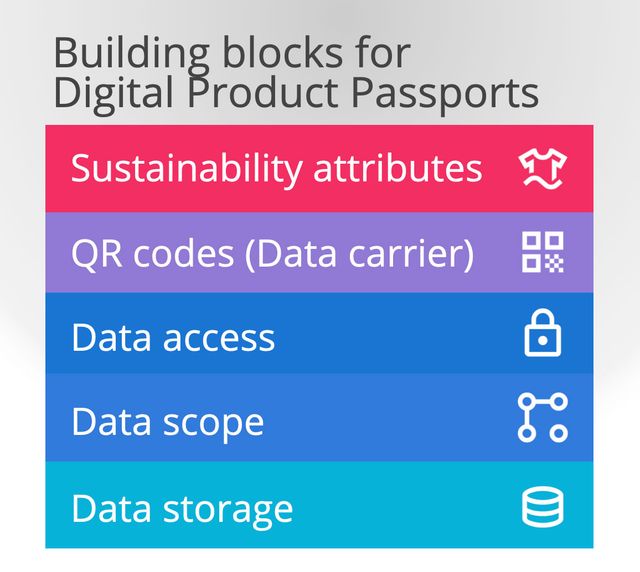
Some of the basic tenets of a Digital Product Passport for fashion include the following:
- Sustainable product attributes. Fashion brands must decide which attributes help communicate the sustainability of their clothing, whether that is information on the durability of the product, the reusability of a garment, its carbon footprint, its repairability, or the expected generation of resulting waste.
- QR codes (Data carrier). The ESPR legislation in the E.U. suggests several methods to connect a consumer with the sustainability data, including via QR code, bar code, radio frequency identification (RFID) tag, or via a product watermark. Of these options, QR codes are one of the most cost-efficient and reliable data carriers for manufacturers to produce, and one of the most familiar and easiest for consumers to interact with. In this case, to view a Digital Product Passport, a consumer simply needs to scan a QR code affixed to a product hangtag with a smartphone.
- Public data access. Clothing manufacturers and fashion brands need to determine whether they make all of their product sustainability attributes available publicly, or whether they have a permissioned access system to some of their data.
- Data scope. Textile producers also need to determine at what level they will apply a fashion-based Digital Product Passport to their goods. They can apply unique sustainability data at the product model or style level (all of the women’s tops in a particular style), at the product batch level (a group of women’s tops in a particular style that were manufactured at a plant during a certain timeframe), or at the individual item level (each individual women’s top). The complexity for data management increases as Digital Product Passports are applied at the batch or item levels.
- Data storage. Clothing producers need to decide where they store their product attribute data, keeping in mind the ESPR stipulations that they ensure data authentication, reliability, and security. Centralised models that store data in the cloud offer familiar workflows, but are subject to security risks and server downtime. Decentralised models store product data on a public, distributed ledger called a blockchain, and ensure data security and integrity by cryptographically authenticating each data transaction. These blockchains also offer data persistence, an important capability that fulfills the ESPR mandate to continue providing Digital Product Passport data even in the face of company insolvency.
Digital Product Passport - benefits for fashion brands
A Digital Product Passport for fashion offers several benefits for not just consumers, but to stakeholders across the value chain. Using a Digital Product Passport for fashion, consumers can access sustainability data that helps them compare products and make better decisions based on sustainability.
Retailers can ensure the authenticity of the products they’re distributing, and manufacturers can make sure their environmental claims aren’t greenwashing. In addition, repairers can get and deliver data on product durability and repair methods, and recyclers can better enable sorting of fibres to reduce waste.
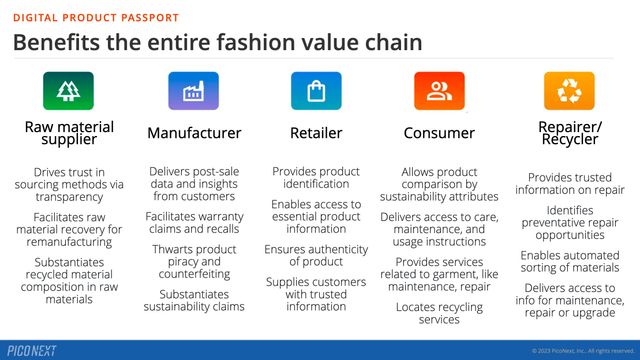
Along with environmental data, manufacturers can provide information on the social conditions under which their garments and fabrics were assembled. This can include data points about the absence of child labour, the absence of forced labour, the fair wage practices of the employer, and the other conditions labourers face. When Digital Product Passports for fashion are tokenised on a blockchain, they can also include verified attestations by third-party auditors who inspect the textile manufacturing facilities and report their findings.
Digital Product Passports as a customer touchpoint
Brand Engagement. Savvy fashion brands will use a Digital Product Passport for fashion as a way to interact with customers and engage them with their brand story. This can include providing brand content along with the sustainability data — like inspirational lookbooks, related pieces that complete the outfit, up-sell opportunities, and even warranty and support information.
Brand Community. Fashion-based Digital Product Passports that use a blockchain can take advantage of additional opportunities, like redeemable loyalty rewards for customers, the ability to programmatically donate to social impact causes important to the fashion industry, and token-gated content that is exclusively available to certain customer groups.

The impact of E.U. Digital Product Passports in other regions
Although Digital Product Passports are targeted at companies that sell and market clothing and textiles in the European Union, sustainability-minded companies will want to investigate the technology for their own products to show customers their progress in environmental initiatives, and to do the right thing. In addition, because of the nature of complex, global, and interconnected supply chains, a regulation that affects one part of the value chain can quickly spread to requirements for upstream suppliers.
Moreover, E.U. legislation often influences other jurisdictions — even distant ones. For example, the California Consumer Privacy Act, followed quickly after the E.U. launched its privacy-conscious General Data Protection Regulation (GDPR).
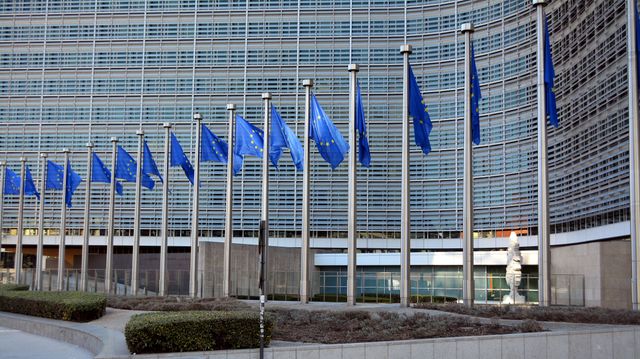
The opportunity for sustainable fashion
Increasingly, Generation Z and Millennial customers seek to align themselves with companies that share their sustainable values. According to Deloitte, the consulting firm, 69 percent of Gen Z consumers are actively trying to minimise their impact on the environment. Fashion brands that substantiate their environmental claims can tap into this growing market segment, overcome customer distrust of greenwashing, and drive customer loyalty — the kind of loyalty that lasts and creates a more sustainable future for all.
Get started with Digital Product Passports for fashion
For more information on Digital Product Passports for fashion, see a demo of PicoNext. And read more about the requirements for Digital Product Passports in our guide to Digital Product Passports.
See a demo of Digital Product Passports
Footnotes
-
European Environment Agency (EEA) (2019) Textiles and the environment in a circular economy, in “EU Strategy for Sustainable and Circular Textiles”, March 2022. eur-lex.europa.eu/resource.html?uri=cellar:9d2e47d1-b0f3-11ec-83e1-01aa75ed71a1.0001.02/DOC_1&format=PDF pg. 2 ↩
-
“EU Strategy for Sustainable and Circular Textiles”, March 2022. eur-lex.europa.eu/resource.html?uri=cellar:9d2e47d1-b0f3-11ec-83e1-01aa75ed71a1.0001.02/DOC_1&format=PDF pg. 3 ↩
-
"How Ecodesign can make our textiles circular", ECOS. 2021. ecostandard.org/wp-content/uploads/2021/04/ECOS-REPORT-HOW-ECODESIGN-CAN-MAKE-OUR-TEXTILES-CIRCULAR.pdf ↩
-
"A New Textiles Economy: Redesigning fashion’s future", Ellen MacArthur Foundation ellenmacarthurfoundation.org/a-new-textiles-economy ↩
-
"Designing for circular fashion: integrating upcycling into conventional garment manufacturing processes", Fashion and Textiles. fashionandtextiles.springeropen.com/articles/10.1186/s40691-021-00262-9 ↩
-
"Investigating options for reducing releases in the aquatic environment of microplastics emitted by (but not Intentionally added in) products", Eunomia. 2018. eunomia.co.uk/reports-tools/investigating-options-for-reducing-releases-in-the-aquatic-environment-of-microplastics-emitted-by-products/ ↩
-
"Plastic in textiles: towards a circular economy for synthetic textiles in Europe", European Environment Agency. 2021 eea.europa.eu/publications/plastic-in-textiles-towards-a ↩
-
“2020 – sweep on misleading sustainability claims”. European Commission. commission.europa.eu/live-work-travel-eu/consumer-rights-and-complaints/enforcement-consumer-protection/sweeps_en#ref-2020--sweep-on-misleading-sustainability-claims ↩

